Conservation status Least Concern | Genus Ipomoea Rank Species Higher classification Ipomoea | |
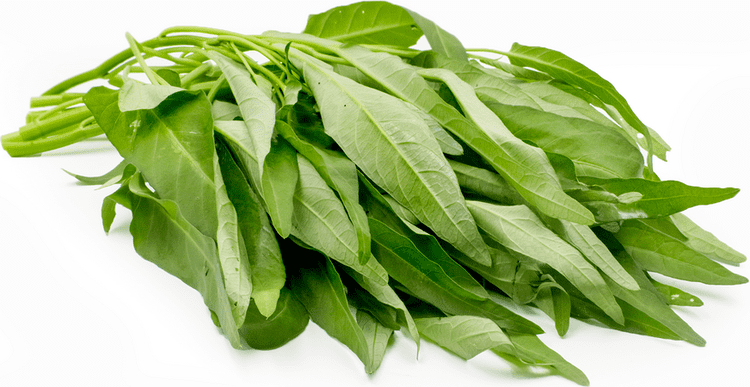 | ||
Similar Water, Shrimp paste, Chinese cabbage, Chinese broccoli, Amaranth | ||
Khmer vegetable 28 ipomoea aquatica
Ipomoea aquatica is a semiaquatic, tropical plant grown as a vegetable for its tender shoots and leaves. It is found throughout the tropical and subtropical regions of the world, although it is not known where it originated. This plant is known in English as water spinach, river spinach, water morning glory, water convolvulus, or by the more ambiguous names Chinese spinach, Chinese Watercress, Chinese convolvulus, swamp cabbage or kangkong in Southeast Asia. Occasionally, it has also been mistakenly called "kale" in English, although kale is a strain of mustard belonging to the species Brassica oleracea and is completely unrelated to water spinach, which is a species of morning glory. It is known as phak bung in Thai and Laotian, eng chai in Teochew and Hokkien, ong choy (蕹菜) in Cantonese, kongxincai (空心菜) in Mandarin Chinese, rau muống in Vietnamese, kangkong in Tagalog, kangkung in Indonesian and Malay, gazun (ကန်စွန်း) in Myanmar, trokuon (ត្រកួន) in Khmer, kolmou xak in Assamese, kalmi saag in Hindi, kalmi shak in Bengali, Thooti Koora in Telugu, "Kalama Saga" in Odia, hayoyo in Ghana. In Suriname (South-America) it's known as dagoeblad or dagublad.
Contents
- Khmer vegetable 28 ipomoea aquatica
- How we grow kang kong kangkung chinese water spinach ipomoea aquatica
- Description
- Cultivation
- Invasiveness
- Culinary uses
- Health effects
- References
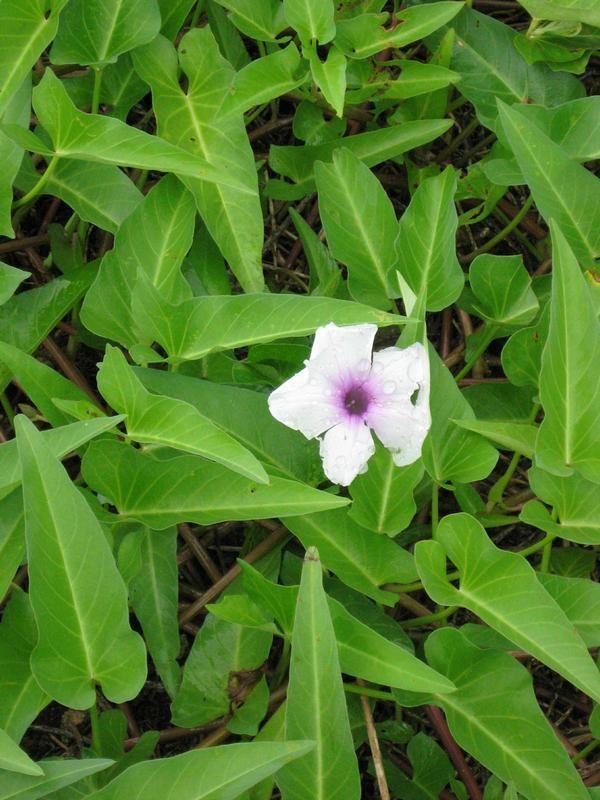
How we grow kang kong kangkung chinese water spinach ipomoea aquatica
Description
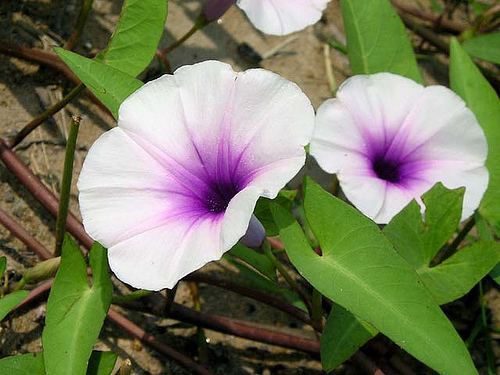
I. aquatica grows in water or on moist soil. Its stems are 2–3 metres (7–10 ft) or more long, rooting at the nodes, and they are hollow and can float. The leaves vary from typically sagittate (arrow head-shaped) to lanceolate, 5–15 cm (2–6 in) long and 2–8 cm (0.8–3 in) broad. The flowers are trumpet-shaped, 3–5 cm (1–2 in) in diameter, and usually white in colour with a mauve centre. Propagation is either by planting cuttings of the stem shoots that will root along nodes or planting the seeds from flowers that produce seed pods.
Cultivation
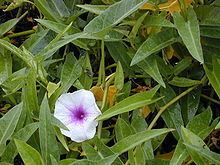
Ipomoea aquatica is most commonly grown in East, South and Southeast Asia. It flourishes naturally in waterways and requires little, if any, care. It is used extensively in Burmese, Thai, Lao, Cambodian, Malay, Vietnamese, Filipino, and Chinese cuisine, especially in rural or kampung (village) areas. The vegetable is also extremely popular in Taiwan, where it grows well. During the Japanese occupation of Singapore in World War II, the vegetable grew remarkably easily in many areas, and became a popular wartime crop. In the Philippines, a variety of kangkong is grown in canals dug during the American occupation after the Spanish–American War, while another variety growing on land is called Chinese kangkong.
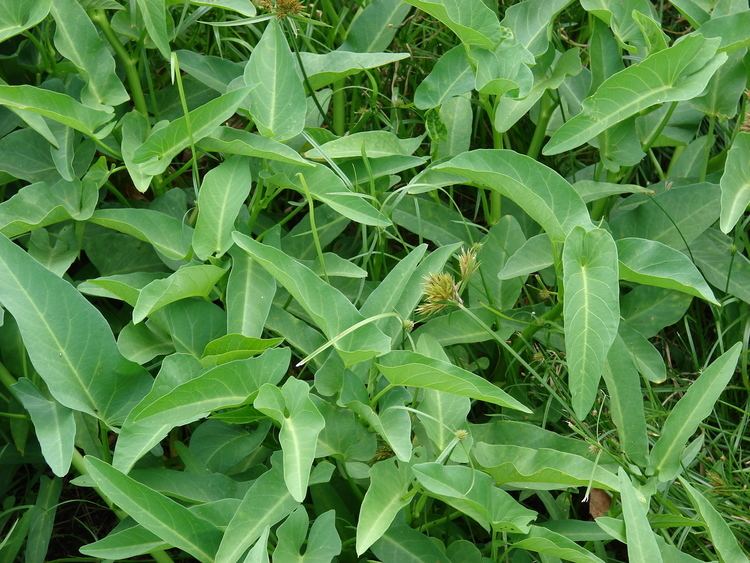
In non-tropical areas, it is easily grown in containers given enough water in a bright sunny location. It readily roots from cuttings.
Invasiveness
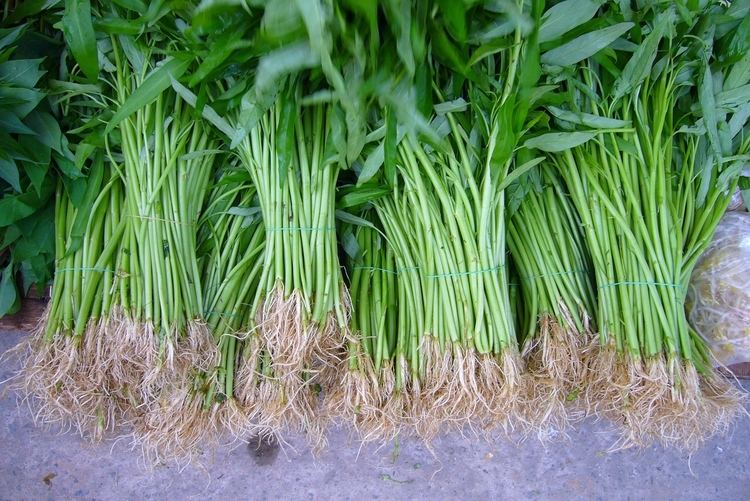
I. aquatica is listed on the USDA internet site as a "Class A noxious weed", especially in the states of Florida, California, and Hawaii, where it can be observed growing in the wild. I. aquatica has been extensively cultivated in Texas for over 30 years, having been originally brought there by Asian immigrants. Because no evidence indicates the plant has escaped into the wild, Texas lifted its ban on cultivation for personal use with no restrictions or requirements, noting its importance as a vegetable in many cultures, and also began permitting cultivation for commercial sales with the requirement of an exotic species permit. In Sri Lanka, it invades wetlands, where its long, floating stems form dense mats which can block the flow of water and prevent passage of boats.
Culinary uses
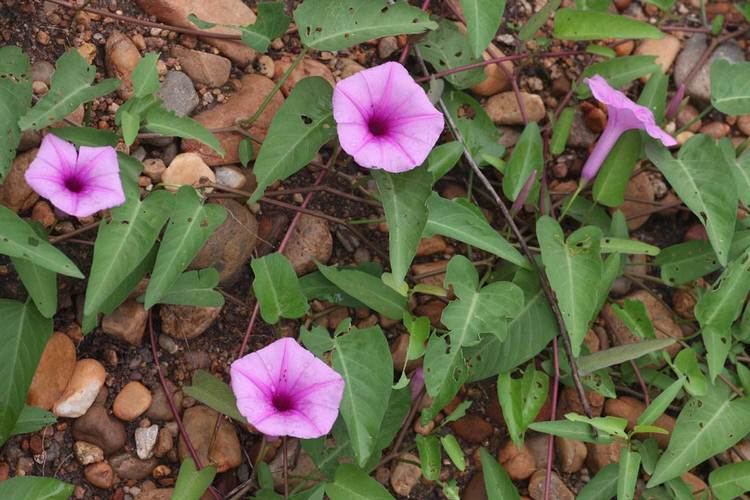
The vegetable is a common ingredient in Southeast Asian dishes. stir-fried water spinach is a popular vegetable dish in Southeast Asia. In Singapore, Indonesia, and Malaysia, the tender shoots along with the leaves are usually stir-fried with chili pepper, garlic, ginger, dried shrimp paste (belacan/terasi) and other spices. In Penang and Ipoh, it is cooked with cuttlefish and a sweet and spicy sauce. Also known as eng cai in the Hokkien dialect, it can also be boiled with preserved cuttlefish, then rinsed and mixed with spicy rojak paste to become jiu hu eng cai. Boiled eng cai also can be served with fermented krill noodle belacan bee hoon and prawn noodle.
In Indonesian cuisine it is called kangkung, boiled or blanched together with other vegetables it forms the ingredient of gado-gado or pecel salads in peanut sauce. Some recipes that use kangkung is plecing kangkung from Lombok, and mie kangkung (kangkong noodle) from Jakarta.
In Thailand, where it is called phak bung (Thai: ผักบุ้ง), it is eaten raw, often along with green papaya salad or nam phrik, in stir-fries and in curries such as kaeng som.
In Vietnam, I. aquatica (rau muống) is a common ingredient and garnish in Vietnamese cuisine and was once served as a staple vegetable of the poor. In the South, the water spinach is julienned into thin strips and eaten with many kinds of noodles. It is also commonly cooked in a sour soup (canh chua), with tomatoes, other vegetables, and some kind of protein. Rau muống is also commonly sauteed with chopped garlic, oil (or pork fat), and fish sauce, known as rau muống xào tỏi (stir-fried water spinach with garlic) and served as a side dish in many meals.
In Laos, where it is known as pak bong (ຜັກບົ້ງ), and in Burma, where it is called gazun ywet (ကန်စွန်းရွက်; MLCTS: kancwan:rwak; [ɡəzʊ́ɴ jwɛʔ]), it is frequently stir-fried with oyster sauce or yellow soybean paste, and garlic and chillies.
In the cuisine of Cambodia, where it is called trakuon (Khmer: ត្រកួន), water spinach is known to have a few types. The popular type is the usual local water plant, used in many traditional dishes. One type is known as Chinese trakuon grown as a straight stalk plant from soil. This type is known to be used in stir fry with pork or just with marinated soy beans (sieng). The Khmer popular dish samlar machu (sour soup) uses water spinach with fish or chicken. Water spinach is also eaten raw or parboiled along with other vegetables in dip dishes, e.g. toeuk kroeung, a sour/salty taste dish, with roughly minced fish mixed with lemon juice, crushed peanuts, basil, and prahok (fish paste) flavour, similar to nam phrik.
In the Philippines, where it is called kangkóng, the tender shoots are cut into segments and cooked, together with the leaves, in fish and meat stews, such as sinigang. The vegetable may also be eaten alone, such as in adobong kangkóng, where it is sautéed in cooking oil, onions, garlic, vinegar, soy sauce, and bouillon cube. A local appetiser called crispy kangkóng has the leaves coated in a flour-based batter and fried until crisp, similar to Japanese vegetable tempura.
Chinese cuisine (Chinese: 空心菜; pinyin: kōngxīncài; literally: "hollow vegetable") has numerous ways of preparation, but a simple and quick stir-fry, either plain or with minced garlic, is probably the most common. In Cantonese, the water spinach is known as 通菜 (Jyutping: tung1 coi3) or 蕹菜 (Jyutping: ung3 coi3, sometimes transliterated as ong choy). In Cantonese cuisine, a popular variation adds fermented bean curd. In Hakka cuisine, yellow bean paste is added, sometimes along with fried shallots.
In South India, the leaves are finely chopped and mixed with grated coconut to prepare thoran (തോരന്), a dish in Kerala. The same dish in Tamil Nadu is prepared as thuvaiyal (துவையல்) or as kootu (கூட்டு).
In Bangladesh and West Bengal, it is known as kolmishak (কলমীশাক) and stir-fried preparation of the leaves is a very popular dish.
Health effects
If harvested from contaminated areas, and eaten raw, I. aquatica may transmit Fasciolopsis buski, an intestinal fluke parasite of humans and pigs, causing fasciolopsiasis.
